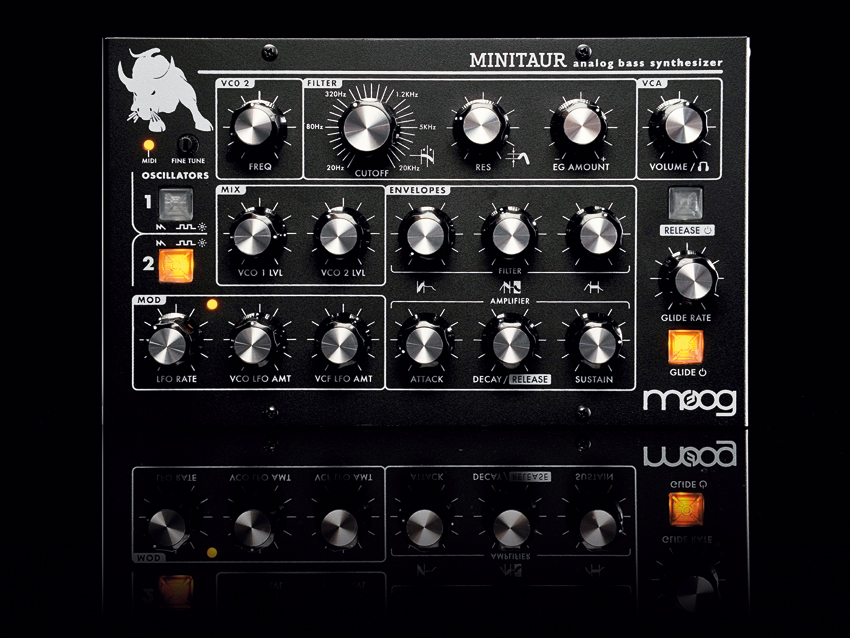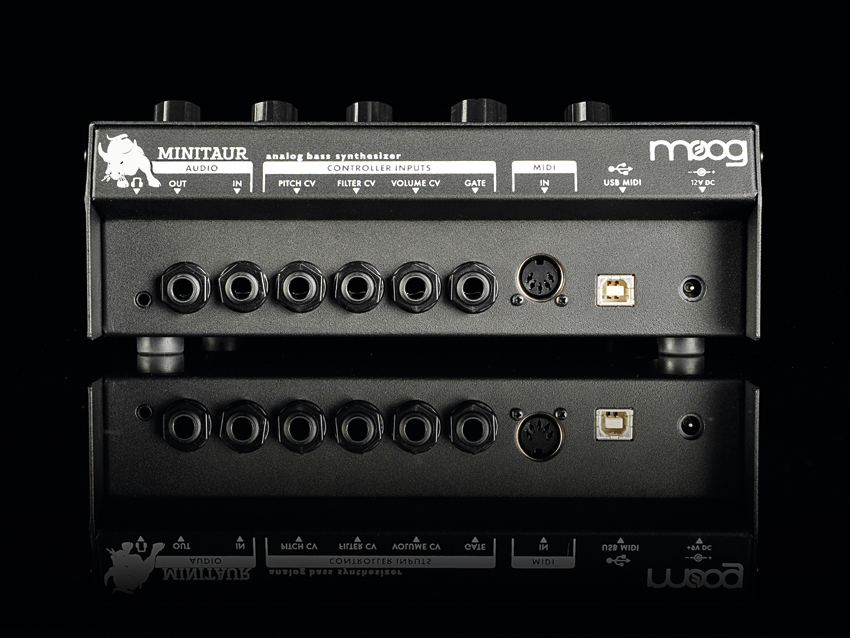MusicRadar Verdict
A powerful, deep bass synth with a flexible future. Well priced and solid Moog build.
Pros
- +
Huge sound; small footprint; classic Moog tones.
Cons
- -
Very little.
MusicRadar's got your back

Moog Minitaur

Moog Minitaur
Back in 1974 it was easy to make light of stacked heels and the other cosmic clobber that littered the pages of the weekly music papers. That is until one of the high priests of Prog Rock set off a Taurus bass bomb in your local sports arena, prompting to you to apologise for smirking at his sequined cape.
The people at Moog remember those days fondly, and for those who weren't around to bear witness they've now come up with the Minitaur bass synth to give you an idea of what you missed out on.
"Despite its size, there's no denying Minitaur's monstrous sound. With only a single oscillator going you can manage a fairly convincing acid-like TB-303 squelch."
Minitaur's raison d'être is to bring a bit of that classic analogue thunder to today's musician in an efficiently designed monophonic knob-per-function package that won't have you eBay-ing off your Van der Graaf Generator collection to help pay for it. The three versions of the beloved Moog Taurus bass pedals that precede it have bequeathed a good chunk of their DNA to the new synth.
And despite eschewing pedals and presets for knobs and ingenuity, this new module can still move a fair amount of air about.
Small packages
Because Minitaur's isn't much bigger than the chunky wood-panelled Moogerfooger pedals the company's also known for, it positions itself straight away as something that can be easily integrated into a keyboard stack, DJ rig, or studio space without too much consideration for space.
On collecting our prototype, it was so light and portable that you're more likely to rethink taking the band's smoke machine to the gig than excluding this modestly-sized piece of kit from the setup.
Because of Minitaur's reduced footprint, however, several design considerations with regards to the amount of physical space available had to be made. One of them was that there wasn't room to cram a power supply into the chassis - leaving you to find another jack for the included wall wart. But that's a niggling point to make, especially when you consider the benefits of sidestepping electrical noise leaking into your analogue signal path, and any additional cost to the synth's retail price.
Knob-landia
While Minitaur is by and large modelled after the Taurus line, welcome differences abound. Starting right beneath the snorting bull logo are the two square plastic VCO switches (coloured amber for "extra warmth" sayeth one clever Moog engineer) that determine which of the waveforms are currently in play.
Departing from the original Taurus design, Moog opted to add a wave shaper to the mix here that enables each of the oscillators to output square and sawtooth waveforms. This tweak obviously brings additional classic bass tones to the Minitaur's sound.
The VCO2 knob will enable you to adjust the frequency of the second oscillator up or down a full octave from VCO1, the centre position being the unison setting. By setting up an interval and dropping the gain on the second oscillator, you can create the effect of adding subtle, yet attractive harmonics to the sound.
A discreetly implemented fine-tuning control is also on board, but it's delivered out of the way and without a knob so as to discourage accidental use.
Another distinguishing feature is that, unlike the crossfading slider on the Taurus I, which ensures you are never actually turning either oscillator entirely off, Minitaur features separate gain controls for both VCOs. This means that with both volume pots wide open you are actually hitting the wide four-pole Moog low-pass filter (which runs between 20Hz to 20kHz) a bit harder than the original beast could and thus making it possible to get a grittier timbre from the instrument.
A triangle wave-driven LFO can be sent to either the VCOs or the Minitaur's filter (via independent knobs), working a range that can go as slow as .01Hz or up into the fast and ultra gnarly spectrum of 100Hz where the associated LED appears as if its having a seizure.
Because of the limited amount of space available on the panel, Moog went back even further into its history and looked to the design of the Minimoog for the Minitaur's envelopes. While using the same three-knob configuration of the Mini's ADSR envelopes, the release segments of both the filter and the amp envelope generators are activated by a third amber switch and controlled with the same knob used to manage decay.
This is subtly (or too subtly) illustrated by the inverted graphics sandwiched between the two Decay/Release knobs, but in use the design becomes quite clear. The envelopes on the original Taurus 1 were actually quite slow as it turns out, but they have been suitably sped up for the Minitaur.
While this can lead to clicky, short attack-like sounds (especially with lower frequencies), this characteristic can be dialled out rather easily if in if that's not what you're after. And in a further tweak to the Taurus engine, the Filter Envelope Generator Amount here can be set to either positive or negative (centre position equates to no EG modulation).
When it comes to the Minitaur's glide function, called into action by a fourth amber switch, the synth boasts the feature of being able to select (via MIDI) between the more modern, linear glide sound that most of us are used to hearing and that of the classic Taurus glide, which had the unique characteristic of rising very quickly and then slowing down before it reached the target pitch. Nice to have the option.
MIDI speak
Every control that you see on the Minitaur's front panel can be managed via MIDI. And because Minitaur speaks MIDI so fluently, you can do things like send it MIDI clock messages, which can be used in turn to tie the on-board LFO to a drum track and turn it into a 'clock divider'.
This enables you to dial in note divisions at will, and make the synth much as rhythmically friendly companion to new or existing tracks that you feel might need a touch more 'oomph'.
All of the panel controls will also send MIDI CCs in addition to their respective parameter responding to said CCs. With the added ability to store any Minitaur presets you devise via MIDI on your computer, the synth keeps its feet evenly planted in the both the analogue and the digital domains.
Back side of the Moog
On the rear of the unit, Minitaur includes a mini headphone jack - the available real estate inside the chassis didn't allow for a full on quarter-inch plug - as well as an audio out jack, and a much requested external audio input, which can be used to overdrive the filter to great effect. The four CV inputs that are also on the backside (Pitch, Filter, Volume, and Gate) are scaled from 0 to 5V.
The Pitch CV input is set to a volt per octave, enabling Minitaur to handle up to five octaves of performance. Because the Filter CV is additive and takes in account the position of both the cutoff knob and the filter's envelope generator, it can sweep about 80% of the filter.
Unlike the Minimoog Voyager or the Little Phatty (where you can plug in a footswitch and trigger notes), the Gate input on the Minitaur requires an actively driven gate signal.
And while there are no CV outs, again owing to space considerations inside the box, the patch-savvy among us will have no trouble coming up with creative ways of patching Minitaur into other modular gear. A standard DIN MIDI input and MIDI over Type B USB connector round out the connection points.
Bull riding
Despite its size, there's no denying Minitaur's monstrous sound. Individually, the VCOs hit hard, especially on the square wave side. With only a single oscillator going you can manage a fairly convincing acid-like TB-303 sound.
But the real fun to be had here is in the combinations you can produce by mixing and matching the oscillator settings. Speaking of oscillators, another of Minitaur's cool little features is that the separate control lines employed for the VCAs enable you to turn the oscillators all the way off while turning up the filter's resonance - giving you a playable sine wave oscillator that can produce high pitched R2D2-like bleeps or a sine wave kick sound on the lower end.
Those who've had the luxury of doing dance music with true analogue bass, know what an asset that sound can be. But a constantly running VCO means that you won't always know where the phase of the oscillator(s) will be when you trigger a note, which can result in sequenced basslines having a seemingly random amount of punch.
By adding Note Sync to the Minitaur, enabled via MIDI CC message, each note played will reset the oscillator phase and thus ensuring the maximum amount of bass punch is delivered.
The quality of the filter is, as you can expect, unassailable. Though we weren't able to A/B the Minitaur's sound up against a vintage Taurus I, the synth easily matches the aural heft of the Taurus 3 pedals we compared it to while being 18 odd kilos easier to tote around.
And while it wasn't ready for us to try at the time of the review, Moog will be rolling out a standalone software editor that will not only give you MIDI control of your Minitaur from your computer, thus offering access to functions not available on the front panel, but will also provide DAW integration and the ability to store and recall your own presets.
The bottom line
It's hard to imagine what else Moog could bring to such a straightforward concept as Minitaur, but members of the company have assured us that they have a very detailed road map sketched out for the instrument over the coming years.
Apart from the upcoming firmware upgrades, and the mention of a rack-mount solution, Moog are keeping the specifics of their plans to themselves. But for those who fancy the idea of basslines that will shake the dust from your speaker cones - or have your flared trousers flapping - this bantam-sized unit is ready for your consideration.
Future Music is the number one magazine for today's producers. Packed with technique and technology we'll help you make great new music. All-access artist interviews, in-depth gear reviews, essential production tutorials and much more. Every marvellous monthly edition features reliable reviews of the latest and greatest hardware and software technology and techniques, unparalleled advice, in-depth interviews, sensational free samples and so much more to improve the experience and outcome of your music-making.
“I called out to Mutt and said, ‘How about this?’... It was a complete fluke": How Def Leppard created a rock anthem - with a little bit of divine intervention
Baby Audio's Smooth Operator spectral balancing plugin goes pro
"It was ugly, like watching a divorce between four people. After a while, I had to get out": Beatles engineer Geoff Emerick on the recording of Abbey Road, track-by-track










